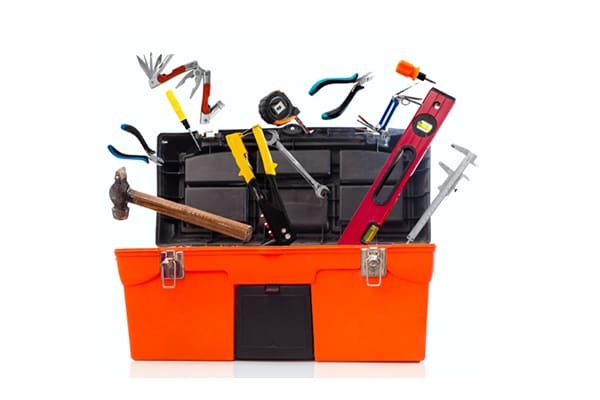A Comprehensive Guide to Essential Tools
Every home, workshop, or professional setting relies on a well-stocked tool box to tackle various tasks and projects. Whether you're a DIY enthusiast, a seasoned craftsman, or just starting to build your collection, understanding what's in a tool box and how each tool serves its purpose is crucial. This guide explores the essential tools commonly found in a tool box, their uses, and why having the right tools can make a significant difference in your work.
1. Hammer
Purpose: The hammer is a fundamental tool used for driving nails into wood or other materials, removing nails, and various other tasks that require force.
Types:
- Claw Hammer: Features a flat striking surface and curved claws for pulling out nails.
- Sledgehammer: A heavy-duty hammer used for breaking through tough materials or driving large stakes.
Usage: Always use the right size and type of hammer for the job to avoid damage to materials or injury.
2. Screwdrivers
Purpose: Screwdrivers are used to drive screws into or out of materials, making them essential for assembling furniture, repairing appliances, and various other tasks.
Types:
- Flathead (or Slotted) Screwdriver: Designed for screws with a single, horizontal groove.
- Phillips Head Screwdriver: Features a cross-shaped tip for screws with a cross-slot.
Usage: Use the correct type and size of screwdriver to match the screw head to prevent stripping the screw or damaging the material.
3. Pliers
Purpose: Pliers are versatile tools used for gripping, bending, and cutting wires or other materials.
Types:
- Needle-nose Pliers: Ideal for precision work and reaching into tight spaces.
- Slip-Joint Pliers: Adjustable pliers that can handle a variety of sizes and shapes.
- Cutting Pliers: Designed for cutting wires and small metal parts.
Usage: Choose the appropriate type of pliers based on the task, ensuring a secure grip and proper leverage.
4. Tape Measure
Purpose: A tape measure is used for measuring lengths and distances accurately. It is an indispensable tool for any project that requires precise measurements.
Features: Most tape measures are retractable, feature a lock mechanism to hold measurements, and have a durable case to withstand wear and tear.
Usage: Always extend the tape fully for accurate measurements and ensure it is aligned correctly with the point of measurement.
5. Utility Knife
Purpose: Utility knives are used for cutting a variety of materials, including cardboard, rope, and drywall.
Features: Often equipped with retractable blades and a comfortable handle, utility knives provide control and safety during cutting tasks.
Usage: Replace blades regularly to maintain sharpness and safety. Always cut away from yourself to prevent injury.
6. Wrenches
Purpose: Wrenches are used for tightening or loosening bolts and nuts. They come in various sizes and types to accommodate different fasteners.
Types:
- Adjustable Wrench: Features a movable jaw to fit various sizes of nuts and bolts.
- Socket Wrench: Uses interchangeable sockets to fit different fastener sizes.
Usage: Ensure the wrench fits snugly on the fastener to avoid stripping or damaging the bolt or nut.
7. Level
Purpose: A level is used to ensure surfaces are perfectly horizontal or vertical. This is crucial for tasks that require precise alignment, such as installing cabinets or shelving.
Types:
- Bubble Level: Contains a small vial with a liquid and an air bubble that indicates levelness.
- Laser Level: Projects a laser beam to provide a level reference over longer distances.
Usage: Place the level on the surface or use the laser to check alignment, making necessary adjustments to ensure accuracy.
8. Drill
Purpose: A drill is used for creating holes in various materials and can also be used with different attachments for driving screws.
Types:
- Corded Drill: Provides continuous power and is suitable for heavy-duty tasks.
- Cordless Drill: Offers portability and convenience with rechargeable batteries.
Usage: Select the appropriate drill bit for the material being drilled and ensure the drill is set to the correct speed and torque.
9. Saw
Purpose: Saws are used for cutting through various materials, including wood, metal, and plastic.
Types:
- Hand Saw: A manual saw for cutting wood and other materials.
- Power Saw: Includes circular saws and jigsaws, which provide faster and more precise cutting with less effort.
Usage: Use the correct saw for the material and ensure blades are sharp and in good condition for clean cuts.
10. Adjustable Spanner
Purpose: An adjustable spanner, or wrench, is used for gripping and turning nuts and bolts of various sizes.
Features: The adjustable jaw allows it to fit different sizes of fasteners, making it a versatile tool.
Usage: Adjust the jaw to fit the fastener securely and apply steady pressure to avoid slipping.
Conclusion
A well-equipped tool box is essential for tackling a wide range of tasks, from simple repairs to complex projects. Understanding the purpose and proper use of each tool, such as hammers, screwdrivers, pliers, and more, ensures that you can handle any job with confidence and efficiency. By keeping your tool box organized and stocked with these essentials, you'll be prepared to address various challenges and complete projects effectively. Whether you're a DIY enthusiast or a professional tradesperson, having the right tools at your disposal is key to successful and satisfying work.
Post time: 09-18-2024




